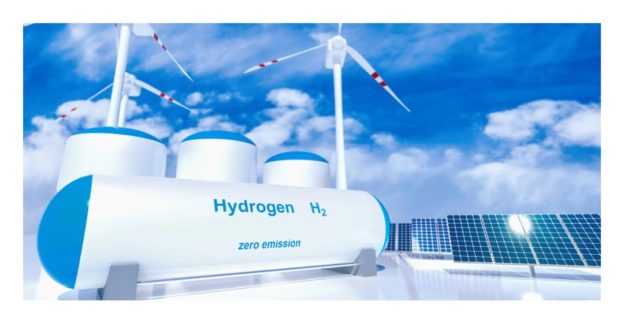- There are many ‘colours’ of hydrogen – each referring to how it is produced.
- Green hydrogen is the only variety produced in a climate-neutral manner.
- It could play a vital role in global efforts to reach net-zero emissions by 2050.
Green hydrogen has been hailed as a clean energy source for the future. But the gas itself is invisible – so why are so many colourful descriptions used when referring to it?
It all comes down to the way it is produced. Hydrogen emits only water when burned. But creating it can be carbon intensive.
So various ways to lessen this impact have been developed – and scientists assign colours to the different types to distinguish between them.
Depending on production methods, hydrogen can be grey, blue or green – and sometimes even pink, yellow or turquoise – although naming conventions can vary across countries and over time.
But green hydrogen is the only type produced in a climate-neutral manner, meaning it could play a vital role in global efforts to reduce emissions to net zero by 2050.
Hydrogen the most abundant element
Hydrogen is the simplest and most abundant element in the universe. On Earth, though, it rarely exists as a gas – so it needs to be separated from other elements.
White hydrogen is a naturally occurring version that can occasionally be found underground, but there are few viable ways of extracting this – so experts instead look to generate it artificially.
Have you read?
Hydrogen can be produced from a range of resources including fossil fuels, nuclear energy, biomass and renewable energy sources. This can be done via a number of processes.
The resulting gas can be burned or used as a carrier to provide energy. And, if generated using renewables, it can be a clean alternative to burning fossil fuels.
Black, brown and grey hydrogen
Grey hydrogen is the most common form and is generated from natural gas, or methane, through a process called “steam reforming”.
This process generates just a smaller amount of emissions than black or brown hydrogen, which uses black (bituminous) or brown (lignite) coal in the hydrogen-making process.
Black or brown hydrogen is the most environmentally damaging as both the CO2 and carbon monoxide generated during the process are not recaptured.
Blue hydrogen
Hydrogen is labelled blue whenever the carbon generated from steam reforming is captured and stored underground through industrial carbon capture and storage (CSS).
Blue hydrogen is, therefore, sometimes referred to as carbon neutral as the emissions are not dispersed in the atmosphere.
However, some argue that “low carbon” would be a more accurate description, as 10-20% of the generated carbon cannot be captured.
Green hydrogen
Green hydrogen – also referred to as “clean hydrogen” – is produced by using clean energy from surplus renewable energy sources, such as solar or wind power, to split water into two hydrogen atoms and one oxygen atom through a process called electrolysis.
Renewables cannot always generate energy at all hours of the day and green hydrogen production could help use the excess generated during peak cycles.
It currently makes up about 0.1% of overall hydrogen production, but this is expected to rise as the cost of renewable energy continues to fall.
Many sectors also now see green hydrogen as the best way of harmonizing the intermittency of renewables – storing excess energy at times of low demand to be fed back into the grid when demand rises – while decarbonizing the chemical, industrial and transportation sectors.
Other colours of hydrogen
Turquoise hydrogen refers to a way of creating the element through a process called methane pyrolysis, which generates solid carbon.
As such, there is no need for CCS and the carbon can be used in other applications, like tyre manufacturing or as soil improver.
Its production is still in the experimental phase.
Then there is pink hydrogen. Like green hydrogen, it is created through electrolysis of water but the latter is powered by nuclear energy rather than renewables.
The extreme temperatures from nuclear reactors could also be used in other forms of hydrogen production by producing steam for more efficient electrolysis, for example.
Meanwhile yellow hydrogen is the term used for hydrogen made through electrolysis of water using solar power, although some use it to mean hydrogen generated through electrolysis of water using mixed sources depending on what is available.
Hydrogen can also be generated from biomass and, depending on the type of biomass and CCS technologies, can have lower net carbon emissions than black/brown or grey hydrogen.
https://www.weforum.org/agenda/2021/07/clean-energy-green-hydrogen/








